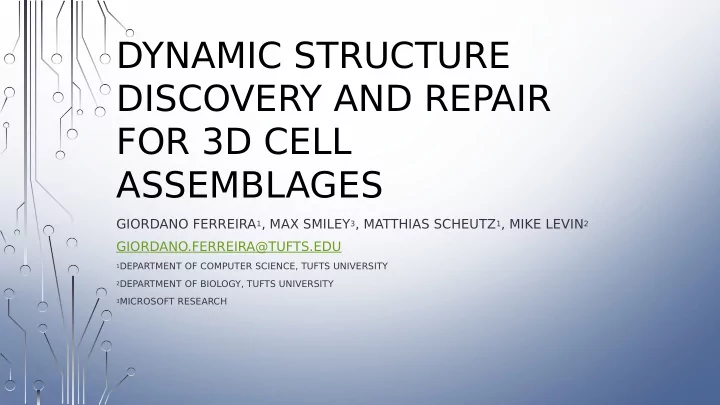

DYNAMIC STRUCTURE DISCOVERY AND REPAIR FOR 3D CELL ASSEMBLAGES GIORDANO FERREIRA 1 , MAX SMILEY 3 , MATTHIAS SCHEUTZ 1 , MIKE LEVIN 2 GIORDANO.FERREIRA@TUFTS.EDU 1 DEPARTMENT OF COMPUTER SCIENCE, TUFTS UNIVERSITY 2 DEPARTMENT OF BIOLOGY, TUFTS UNIVERSITY 3 MICROSOFT RESEARCH
INTRODUCTION
MOTIVATION • How does a group of cells cooperate to build and maintain complex anatomical structures? • An answer for this question can create new hypothesis for research in areas such as regenerative medicine, aging research and degenerative disease
HOW DOES THE REGENERATION INFORMATION IS ENCODED? • First hypothesis: Genetic Encodings • Morphological information is stored in and recovered from gene expressions
RELATED WORK • The problem of structural maintenance has been approached by the artifjcial life community through the use of genetic algorithms, agent-based models and cellular automata • Overall, all past approaches have been used some kind of genetic encoding.
GENETIC ENCODING DRAWBACKS • Evidences have been found that a genetic encoding approach is not valid in all cases. • For example, ectopic growth on deer’s antlers after a injury persists through several subsequence shedding and regenerations
DYNAMIC MESSAGING MECHANISM • Does not rely on any genetic encoding • Morphological information exists across cells • Behavior of cells depends on the messages they receive from neighbors cells • Critical advantage: it can dynamically learn and maintain new morphologies using the same mechanism
THE COMMUNICATION MODEL • An agent based model that uses a dynamic messaging mechanism and can discover the morphology of a 3D cell structure, and then maintain this structure indefjnitely, in the light of random damages that occur as part of natural aging
DISCOVERY AND REGENERATION • Cells send messages to other cells containing information about the path that those messages traveled. • Then those message packets ”backtrack” verifying if there exists a missing cell in the previous path, repairing it.
DISCOVERY
REGENERATION
REGENERATION
REGENERATION
PLANARIAN FLATWORM
MODEL PARAMETERS • Frequency of packets • Minimum vectors to hold a packet • Minimum length of the top vector • Probability of bending • Minimum number of bends before backtracking
SIMULATION EXPERIMENTS • Goal: verify if the model is capable of maintaining the structure of an organism over time even though random cells are dying over time • 3D structure containing 8 layers with 339 cells per layer – total 2712 cells • Each cell contains 12 neighbors
SIMULATION EXPERIMENTS • We ran the simulation for 500 cycles • We expect the structure has at least 90% of living cells in all cycles • Random death probability: 0%, 1%, 2%, 3% and 4% • Packet frequency: [1,4,7,10,13,16,19,22,25,28,31] • Min vectors to hold: [1,3,5,7] • Min top length to bend: [1,3,5,7] • Bend probability: [0.2, 0.3, 0.4, 0.5, 0.6, 0.7, 0.8, 0.9, 1.0]
RESULTS • 50688 data points with death probability greater than 0 • In 28961 data points the structure was maintained
RESULTS – RANDOM DEATH PROBABILITY
RESULTS – BENDS BEFORE BACKTRACKING
RESULTS – LENGTH BEFORE BENDING
DISCUSSION • We hypothesize that it is possible to regenerate the worm from various systematic cuts where a large part of the body is removed • For that, it is necessary that a subset of alive cells holds packets that cover all removed cells which would be regenerated during backtracking
DISCUSSION • Proposed mechanisms are general enough to work for a very large set of structures. • A structure will be maintainable depending on how cells die and how many bends packets can have. • More complex structures need more bends to cover them all
CONCLUSION • Agent based model of structure discovery and repair • As future work, we would like to perform non-equally distributed cell deaths (e.g., cluster deaths) • We also would like to investigate the regeneration from cuts that in vivo worms present
Recommend
More recommend